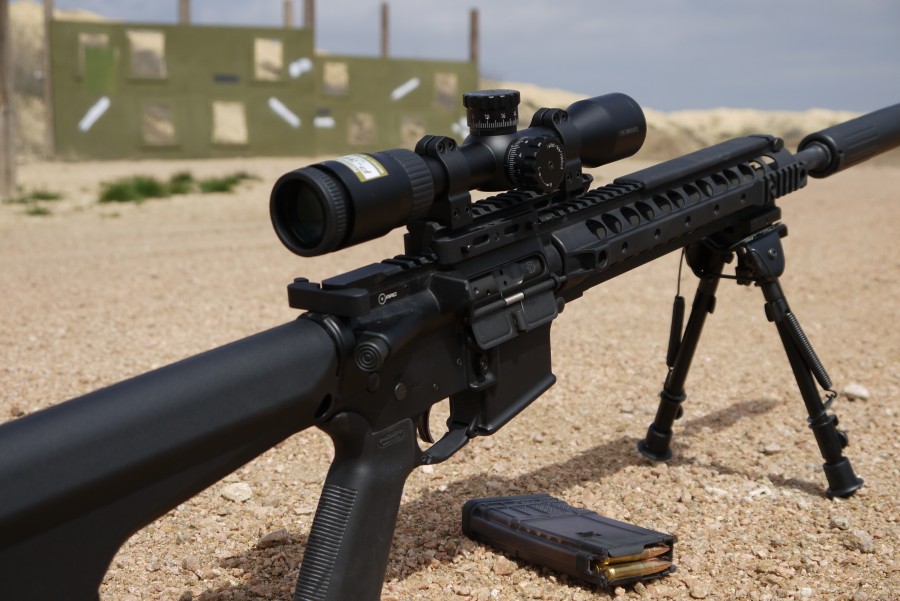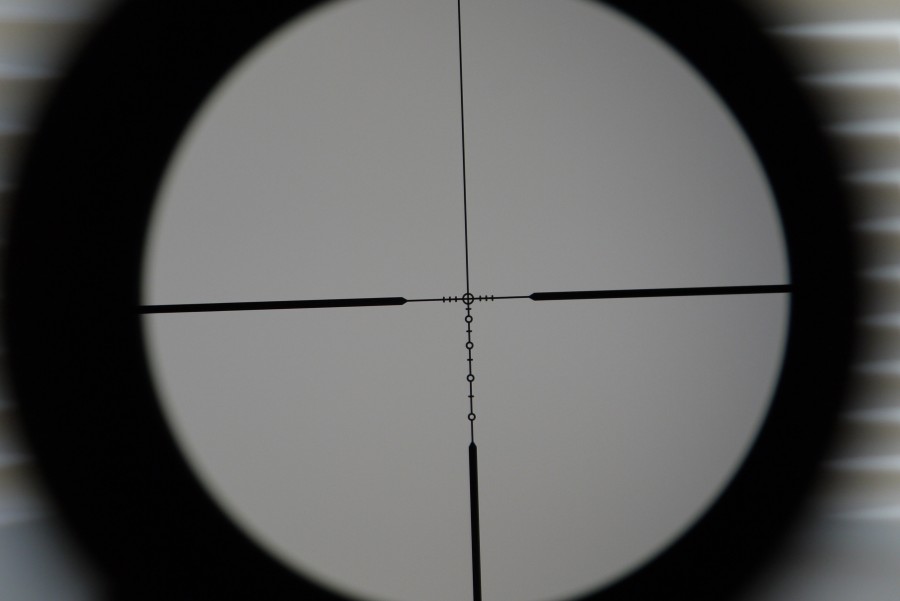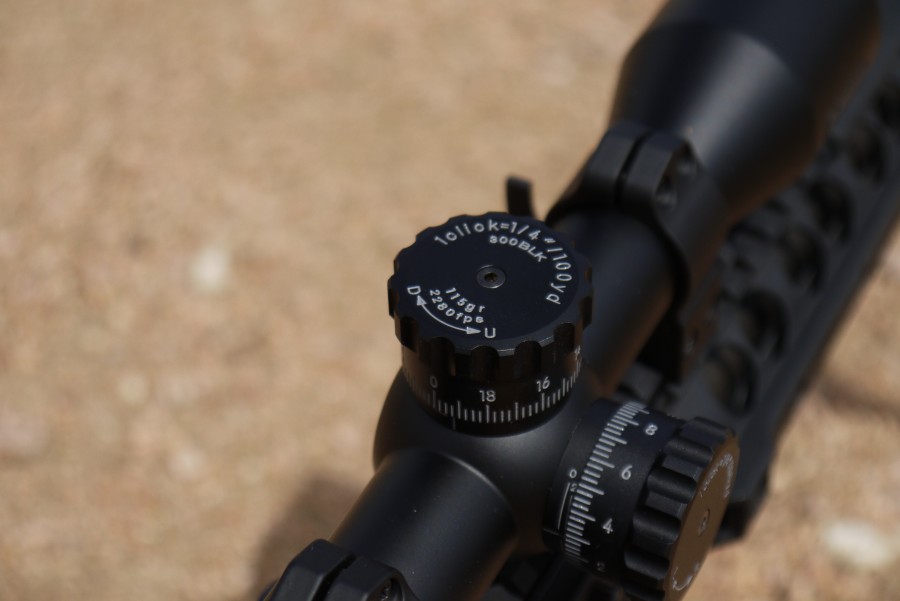I’m not usually a fan of “bullet drop compensated” or “BDC” reticles. The markings on the scope never seem to actually match up with the trajectory of the projectile. And usually that has something to do with the manufacturer not letting you know the particulars of the projectile they used to zero the scope. However, with the 300 AAC Blackout cartridge, the ballistic profile is different enough from the standard 5.56 trajectory that having a BDC reticle makes sense. And the one Nikon just released may be the best out there . . .
The Nikon scope uses a fairly nifty reticle design. It’s still the same familiar BDC style, but instead of solid hash marks at the different distances, the scope has open circles to allow the shooter to better see their target. On the other side of that coin, if your target isn’t precisely 500 yards away then the circles might actually obscure more of the target than they show. The reticle claims to be calibrated for both super and subsonic ammunition, but I couldn’t find any reference to the subsonic substentions in the manual.
Last year, Leupold came out with their take on a 300 BLK scope, a variant of their Mark 4 MR/T scope. The reticle design was interesting as it showed markings for both supersonic and subsonic ammunition on different sides of the reticle, and looked great in theory. Unfortunately, I could never find a commercial load that actually lined up with what was engraved on the reticle. That was my biggest gripe, and one that caused me to kick its final score down a couple notches.
Whether Nikon was listening to my complaint or not I’ll never know, but etched onto the elevation turret is something that every BDC scope needs.
Right there, in plain English, it gives you all the relevant information you need to figure out what loads your scope will match up with. This scope is calibrated for 115gr projectiles traveling at 2280 feet per second, which exactly matches up with Remington UMC 300 AAC Blackout cartridges. And out on the 1,000 yard range in Liberty Hill, Texas, I confirmed that the reticle markings do indeed match up with the listed ballistic properties. I was hitting the 500 yard steel plate with boring repetitiveness, as well as if I were using my bolt gun.
Besides listing the ballistic properties, the scope differs from Leupold’s offering in two other ways. While the Leupold scope is a 1.5-5 variable power scope, Nikon’s optic is a 2-7 power. You sacrifice a little extra on the lower side of the magnification range, but gain some on the higher end. For hunting, I actually like that spread a lot. 2x is about what I leave my scopes on when I head out into the field, so having a 1x magnification of some sort isn’t a dealbreaker for me.
Another difference is that the Nikon is a second focal plane scope. This is especially important with BDC-style scopes as a second focal plane reticle means that the distance markings are only useful at full magnification.
Leupold’s scope is a first focal plane scope, meaning that the distance markings on the reticle will remain the same and useful no matter what the magnification. Since you’d want to be at full magnification anyway if you’re shooting at 250 yards or more this isn’t a big issue, but it’s slightly annoying to someone like me who likes their markings to always align with the proper flight path.
The differences between Nikon’s offering and Leupold’s continue — 1 inch versus 30mm tubes, non-illuminated versus illuminated, foreign versus domestic companies… — but there’s only one comparison that really puts one scope over the other. Leupold’s offering costs a whopping $1,750. Nikon? $200. That’s right, for the price of another tax stamp you have a 300 BLK scope. At that price I’d happily live with my minor gripes.
Nikon P-300 BLK 2-7X32 Rifle Scope w/ SuperSub Reticle for .300 AAC Blackout
Weight: 16.1 oz.
Length: 11.5″
Adjustments: 1/4 MoA
Tube: 1 inch
MSRP: $200
Ratings (out of five stars):
All ratings are relative to similar products, final rating is not derived from the preceding ratings.
Optical Clarity * * * *
I really can’t tell the difference between this and the Leupold scope.
Feel & Function * * * *
Everything feels right and is self-explanatory. It does, however, feel a bit…cheap.
Overall Rating * * * *
I’m not exactly crazy about a scope with a BDC reticle on the second focal plane, but the price is very right.









As the instructors on long range rifle shooting will tell you, never buy a BDC scope as you are now locked into one caliber and one load. You are better off buying a the Horus or a good Mil – Dot or MOA – Dot scope with the Larue mounts, then you can switch your scope to different rifles. I am a firm believer in this approach.
I tend to aggree for my purchases.
On the other hand, if you own and shoot a bunch of different guns it could get pretty tedious to check/update your dope sheet every time or try to memorisze each load. I’m not a many-rifle guy, but could see where BDC is close enough for all the trouble it saves those that casually use five or so different rifles, espicially for $200.
Bill… does your opinion change at all when you take Nikons Spot On app into consideration? I am probably wrong here but I thought it let you use the scope witn other calibers if you wanted.
Bill,
Go here: http://spoton.nikonsportoptics.com/spoton/
Grab a small notepad that you can keep in your pocket. Select what scope you have. Key in your zero distance. If you know the speed of your ammunition(many have this on the side of the box), key it in. If not, find the manufacturer and bullet you are using. Click “Fire” near the bottom. Now, go to the minimum zoom, and write down where the BDC markings will actually be. Then move up to the next zoom level. Do the same, and so on for the rest of your magnifications. If you only use one specific zoom all the time, only worry about writing that down. For me, I am fortunate. Even though mine is calibrated for the 55 grain polymer tip traveling at 3240fps and I use a 62 grain traveling at 3050fps, it was able to tell me the proper distances. Since I am not worried about EXACT, I know that at the minimum zoom(3x), I can simply calculate it as being pretty close by saying “Take whichever marking, divinde it by 100, and then multiply that by 150.” Meaning the 200 yard reticle would be about 300 yards(289 actual), the 300 be 450(450 actual), the 400 is about 600(582 actual), when it becomes pretty inaccurate with the 500 calculated at 750(710 actual), and the 600 being calculated at 900(818 actual). However, if I am shooting at 300 yards, there is no way I am going to be using 3x zoom. I will probably be cranked all the way to the 9x zoom. Then I can just estimate that it is shooting at 0.9x what the reticle is. This means 200 would be 180(182 actual), the 300 being 270(265 actual), the 400 being 360(345 actual), the 500 being 450(430 actual), and the 600 being 540(512 actual). While they aren’t dead on, I am willing to take that math, as I will assume that at guessing 500 yards away, I am liable to be off by a bit with my estimate.
Oh yeah, and if you REALLY just don’t like the turrets, you can always order the proper ones for what you are using. For example, I could order the Tul knob for the .223 and it would have the correct speed and coefficient for my ammo. Then it would be ranged for 500 yards.
There are A LOT of options with this scope.
There are and I don’t mean to disparage scopes of this type out of hand. Whatever floats your boat. But, I am of the opinion that you are better off with a good MIL or Horus scope you can switch. This is just MY opinion, others may vary. I guess I have been influenced by recently watching “The Art of the Long Range Rifle” DVDs. Sorry Guys.
Please don’t take it as me saying you are wrong. I certainly don’t feel that way. You prefer mil-dot. I prefer BDC. Diff’rent strokes fer diff’rent folks. For me, I just find it easier to carry a little notepad with the ranges for each dot at each zoom. It is just my preference. I found it easier to just use their spoton thing and write down what it says for if I am at the farm and don’t have targets at a known range. I figure as accurate as I will guesstimate them to be, they will be useful enough. It works pretty well for me, but if a mil-dot scope works better for you, use it.
To me, for 200 bucks, and having something that is pretty damn accurate with any bullet I have tried so far, I can’t really argue with it. Even though I am good with math, I don’t want to be doing all those calculations on the fly.
Since I do most of my shooting at ranges and controlled areas, I just find it quicker to use the BDC. It is just my preference.
I disagree. Learning mil dot is rather difficult. I mean, look at this website trying to simplify it:
http://www.mil-dot.com/user-guide
Range estimation is anything but intuitive. It requires serious preparation and training to use correctly. Yeah, you can go from load to load, caliber to caliber, rifle to rifle… but you still need to learn the new ballistics of the load.
OTOH, BDC dot with ranging? Way easier. And if the cost is being locked into a single load for optimal performance, well, price paid. For some calibers (7.62×39, 5.45×39, etc.) this isn’t even much of a sacrifice.
ye but at $200 a pop for the p-series you can own one for each rifle and never have to switch them out
if I wanted I could pull my Leapold vx3 3.5-10 40mm off of my bolt and use it on my 300aac but I would never do that because my remington 270 has been married to my Leapold for 28 years and is still dead on at 100 yards and have taken deer out to 500 yard with it custom bedding done to stock and weaver mounts and the rifle to this day has never let me or my son down
and my 300aac will be the same
I will never take the scope off once it is mounted unless damaged and being replaced
and I plan to do the same with my 5.56 20″ build with by-pod that my daughter shoots
thinking the p223 may be the way to go for it
This is good to hear! I’m seriously considering 300BLK for my next build and I was hoping you guys would put up a review of this scope. Thanks Nick.
Nikon has a wonderful website for calculating the ballistics of their various scopes with various rounds along with the yardage for each mark (hash or circle) at various magnification settings: http://spoton.nikonsportoptics.com/spoton/
I’ve found it to be very accurate.
Not to mention apps for iOS/Android.
You can even plug in hand loads.
“The reticle claims to be calibrated for both super and subsonic ammunition, but I couldn’t find any reference to the subsonic substentions in the manual.”
Seriously? It does not have any references for subsonic ammo? This is enough to throw the scope in the garbage IMO. I was looking for a cheap option for the top of my handi-rifle, and I had thought this would be it… I guess not.
“Seriously? It does not have any references for subsonic ammo? This is enough to throw the scope in the garbage IMO.”
This is a silly reaction for a couple of reasons…
1) Most of the guys who are running subs are running then on SBR’s (mine is an 10″, 1:8 LW). I don’t know how often a guy running a 8″-10″ SBR is going to strap on a 2-7X scope – hell, I laugh at myself whenever I turn on the EOTech!
2) There are only a handful of subsonics out there. Of the ones I have had a chance to shoot, not a single pair were close enough in performance for a BDC reference to be accurate. Nikon would need pages upon pages of references – taking into account bullet weight and barrel length. This is easily accomplished by the owner using the SpotOn software.
3) This is tied to #1 – Most people using these scopes are punching paper or hunting. Hunting anything other than varmints with subsonic 200+ grain non-expanding poly-tipped bullets is a dumb idea and further makes a BDC reference unnecessary…
Too bad it does not have a 30 mm tube, but for the price I may still have to purchase this scope.
I went to the spot on website and tried a few different manufactures and bullets (including the Remington UMC) and i didn’t find any that gave yardages that were “even” on the markings. They are all odd ball yardages which would make it difficult at a gun range. Am i missing something here? Thanks.
Nick, what scope mount did you use in the pics above?
Very helpful. While I have been doing precision shooting for 40 years I think at a level of generality there are people who will be happy to buy a product like this because the overall architecture is designed for the 300 Blk, and the scope is reasonably priced. The rest of it is just stuff most people won’t figure out either way.
Nice review from somebody that also gets the $1.7K scopes for free. Keep up the good work!
Which scope base and rings are those? The setup looks very nice.
Based on my experience, I think Nikon has the best scopes for your money. Not too expensive…but good performing scopes.
People complaining about the precision markings on the BDC are missing the point of a BDC all together. It is about ease of use, not sub MOA reference. If you need that kind of precision you need to go with an expensive Leopold with mil dot markings (they are the best you can buy IMO). I look at this as a good hunting scope that I don’t mind pulling through the dirt and grime. In the field a lot of shots are estimated yardage and not exact, most people I know using a 300BLK for hunting are using it for sub 200 yard shots anyway.
I have found that when you pair these scopes with the Nikon Spot On app it is pretty dang accurate. When swapping from Remington 125gr (2215 fps) ammo to Remington 220gr SubSonic (1015 fps) ammo at the range I shot several rounds and determined on paper there was approximately a 12″ difference in hold points at 100 yards between the two rounds. I then loaded the Spot-On app on my phone to check the reference, what do you know, the app calculated a 13″ difference. That is not bad for a $200 scope and a $10 app on your phone. After adjusting the scope and checking the BDC range impact on paper vs. the app I found it to be very close; at least enough for deer or hog hunting anyway. This is one of those rare occurrences that you get more than what you pay for.
I agree, the price difference alone is enough to push me towards the Nikon. Although not “American Made” most manufactures that have gone to outsourcing rifle scopes maintain top quality control. I definitely think for the money compared to the Leupold at about 8X the price; its a no brainer.
Mounted this on a 300 Blackout, it;s intended purpose. Scope is clear edge to edge, adjustments are sharp, eye relief is great. I used P-Series Mounts set at T4. Took 6 shots to sight it, last 2, touching at 2 inches high at 100yds, with 150gr Hornady.
I use Strelok Pro and shot 110 Sierra and 178 Hornady. Only counting clicks to make elevation adjustments and shooting the 110s and 150s at 200yards. It appears to hold zero, mind you that is with only 31 shots of starting handloads. My only negative, if it’s that, I don’t think,on a 300 Blackout, you need reticle subtensions past 400yds.
Thinking of getting another one for a LR308.
I like shooting and hunting as well.I notice Dimension , MOA, eye relief ,Reticle etc.I need for a bench rest target shooting scope discussions and helps to selecting best .I have recently discovered a site best riflescope covered with clear and concise design of this new turret .However,Nikon P-300 BLK Riflescope is considered the king in the realm of scope.Besides, I am fond of bestsniperriflescope for hunting in the coastal bay in Scotland.
Go ahed
Andrew Morison
gun
Night vision scopes for hunting are often overlooked by even the most avid hunter because they seem cumbersome and unnecessary. But night vision scopes with thermal detecting can greatly enhance your hunting capabilities in harsher environments and weather, thus enabling you to hunt more animals that ever before.